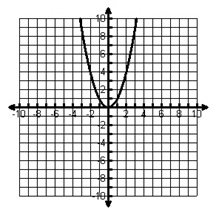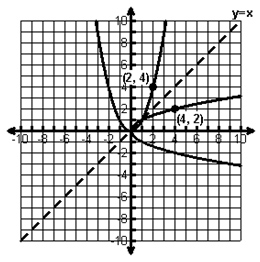Equation
y = x2
Graph

Table
| x | y |
| -3 | 9 |
| -2 | 4 |
| -1 | 1 |
| 0 | 0 |
| 1 | 1 |
| 2 | 4 |
| 3 | 9 |
The inverse of a function is obtained by switching the x- and y-variables in the function. The inverse of function is written as f -1. The new relation obtained by reversing the x- and y-values is not necessarily a function itself. The new relation is only a function if the original function is a one-to-one function .
Shown below are three representations of the quadratic parent function.
Equation y = x2 |
Graph
|
Table
|
The quadratic parent function (y = x2) is not a one-to-one function because elements of the range correspond to more than one element of the domain. For example, when y = 9 the domain is -3 and 3, or the range 9 corresponds to -3 and 3. Since it is not a one-to-one function, the inverse of this function is a relation.
To find the inverse of this function from the equation, begin by exchanging the x- and y-variables in the equation and then rewrite the equation in y = form.
y = x2
x = y2
y2 = x
√y2 = √x
y = ± √x

When given a table, the inverse of a function is found by reversing the x- and y-coordinates of the original function.
| f(x) | |
| x | y |
| -3 | 9 |
| -2 | 4 |
| -1 | 1 |
| 0 | 0 |
| 1 | 1 |
| 2 | 4 |
| 3 | 9 |
| f -1(x) | |
| x | y |
| 9 | -3 |
| 4 | -2 |
| 1 | -1 |
| 0 | 0 |
| 1 | 1 |
| 4 | 2 |
| 9 | 3 |